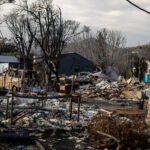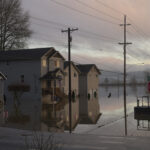Floridians can go back to worrying about hurricanes.
Scientists said last Sunday’s magnitude 6.0 earthquake that rattled windows from southwest Florida to Louisiana was rare, and a seismic jolt powerful enough to do damage or unleash a tsunami on the U.S. Gulf Coast is unlikely.
“Hurricanes are always going to be a bigger threat than earthquakes in Florida,” said Eugene Schweig, a Memphis, Tenn.-based U.S. Geological Survey geologist who specializes in East Coast earthquakes.
Florida is an unlikely spot for an earthquake because it is far from the boundaries of the massive tectonic plates that make up the Earth’s crust. California, on the other hand, is perched atop the intersection of the Pacific and North American plates. On Monday alone, scientists had recorded 23 earthquakes in California by 4 p.m. None were strong enough to be noticed by residents.
“People in Florida haven’t awakened and found themselves in the same boat as people in Los Angeles,” said Jeffrey Park, a professor of geology and geophysics at Yale University.
But that doesn’t mean the Sunshine State can count on shake-free living. And damage is possible.
“Earthquakes are possible anywhere and Florida is no exception,” Schweig said. “There is always the possibility of an earthquake in the place you don’t expect it.”
The epicenter of last Sunday’s earthquake was about 260 miles southwest of Tampa, about 18 miles beneath the Gulf of Mexico. As of Monday afternoon, the agency had received more than 5,500 reports of shaking, mostly from Florida’s panhandle and west coast.
The reports noted the intensity of the shaking was “light.” No major damage was reported. Many people didn’t even notice it.
The earthquake was not powerful enough to trigger a tsunami. But Park said that doesn’t mean Gulf Coast residents can ignore the threat.
“If there were a massive magnitude 7.0 earthquake, I’d advise people to get off the beach,” Park said. “You’d probably still be safe in Disney World.”
Sunday’s earthquake was the largest in the eastern Gulf of Mexico in 30 years.
Only one earthquake has caused notable damage in Florida. In January 1879, St. Augustine residents reported heavy shaking that knocked plaster off the walls.
A November 1952 temblor prompted a resident of Quincy to report the shaking “interfered with the writing of a parking ticket,” the USGS said.
A 1991 University of Florida study reported seismic activity strong enough to be felt on land in 1978 when tremors strong enough to rattle windows were reported in Polk County.
Sunday’s temblor was a rare “midplate” earthquake where pent up energy from faraway plate collisions is released in random spots. There is no way to tell where the earthquake will strike. Scientists are intrigued by Sunday’s temblor because the USGS recorded a magnitude 5.2 earthquake in the same spot on Feb. 10.
Neither earthquake caused damage, primarily because the epicenter was so far from land.
Park was not surprised the USGS received reports Sunday of weak shaking from as far away as Winston Salem, N.C., more than 760 miles from the epicenter of the quake. He said energy travels more efficiently in tectonic plates far from friction areas.
Was this article valuable?
Here are more articles you may enjoy.

 California Again Delays Wildfire Protection Rules for Homes
California Again Delays Wildfire Protection Rules for Homes  Pacific Northwest Braces for Even More Flooding Rain This Week
Pacific Northwest Braces for Even More Flooding Rain This Week  Trump Sues BBC for $10 Billion Over Documentary Edit
Trump Sues BBC for $10 Billion Over Documentary Edit  NYT Asks Judge to Dismiss Trump’s ‘Implausible’ Defamation Suit
NYT Asks Judge to Dismiss Trump’s ‘Implausible’ Defamation Suit 